1. spring boot 简介
Spring Boot 是由 Pivotal 团队提供的全新框架。Spring Boot 是所有基于 Spring Framework 5.0 开发的项目的起点。Spring Boot 的设计是为了让你尽可能快的跑起来 Spring 应用程序并且尽可能减少你的配置文件。
1.1 springboot的好处
① 创建独立的 Spring 应用程序
② 嵌入的 Tomcat,无需部署 WAR 文件
③ 简化 Maven 配置
④ 自动配置 Spring
⑤ 开箱即用,没有代码生成,也无需 XML 配置。
1.2 spring boot 快速入门
(1)JDK 环境必须是 1.8 及以上,传送门:jdk1.8.191 下载
(2)后面要使用到 Maven 管理工具 3.2.5 及以上版本.
(3)开发工具建议使用 IDEA
创建步骤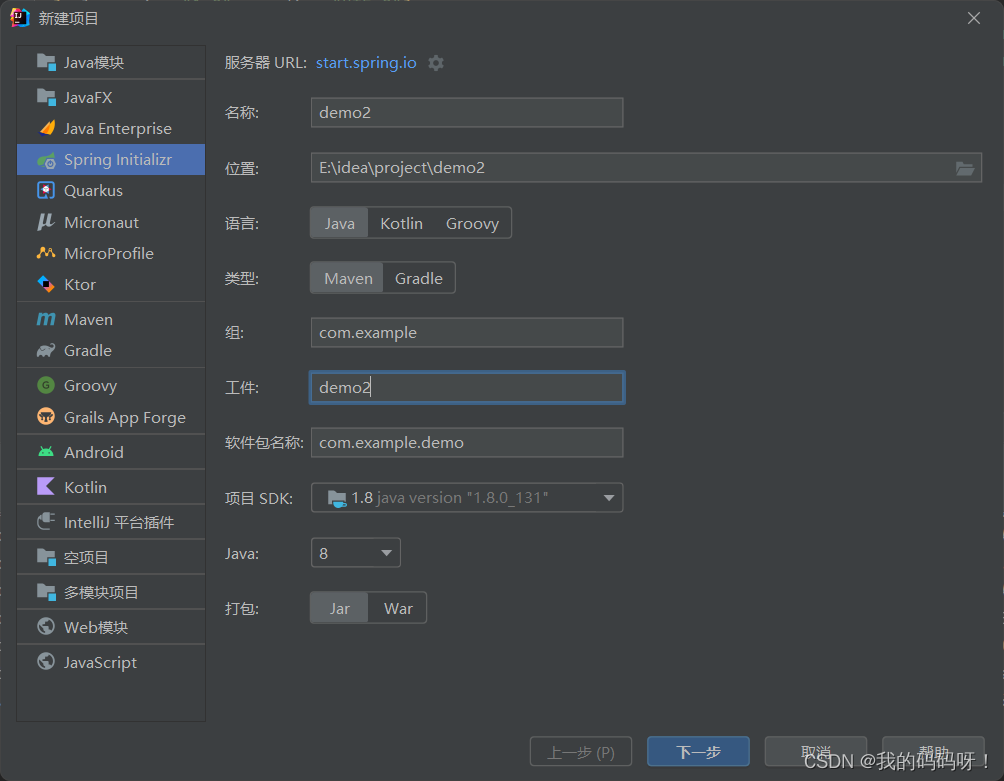
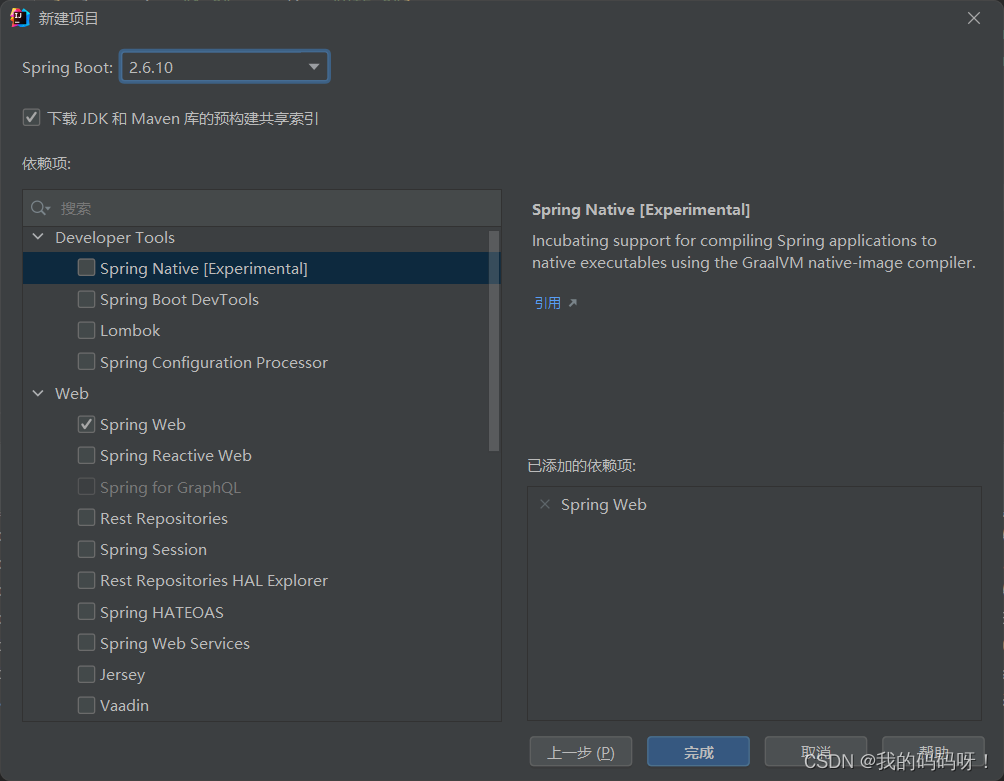
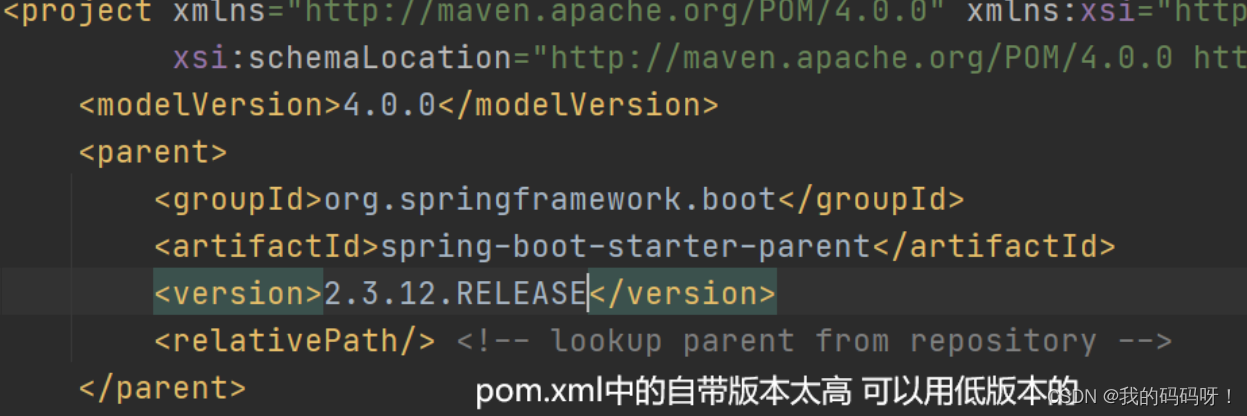

默认springboot扫描的包为主启动类所在的包以及子包。
测试:
@RestController
public class Hello {
@GetMapping("/hello")
public Map<String ,Object> hello(){
Map<String,Object> map=new HashMap<>();
map.put("name","wang");
return map;
}
}
运行程序
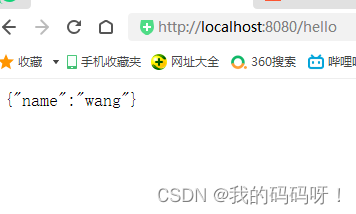
1.3 springboot的配置文件
第一种: properties属性文件
# 修改springboot中tomcat端口号.
server.port=8888
第二种: yml文件
server:
port: 6666
不管是哪种,他们的名字必须以application开始。
如果两个配置文件同时存在,而且有些内容一样。按照properties的优先级高。
如果有些不一样,两个配置文件不一样的会合并在一起。
yml文件的语法
student:
id: 1
name: xiaoming
age: ${a.age}
hobby:
- LOL
- DNF
- CF
- LOL
lists:
- LOL
- DNF
maps:
k1: v1
k2: v2
sets:
- LOL
- DNF
- CF
- LOL
birth: 2019/12/12
a:
age: ${random.int(1,100)}Properties 没有层级关系 使用=赋值
yml 有层级关系 使用: 赋值
两种语法的配置是互补的
读取springboot配置文件中的内容
在application.properties中写入
student.name=zs
student.age=18
student.hobby[0]=sing
student.hobby[1]=swimming
student.map.clazz=qy151创建实体类 将读取application.properties配置文件中的值并赋值给Student类中的属性
@Data
@Component //该类对象的创建和销毁都有spring容器来管理
@ConfigurationProperties(prefix = "student") //读取springboot中的配置内容,读取以前缀为student
public class Student {
String name;
String age;
String[] hobby;
Map<String,Object> map;
} 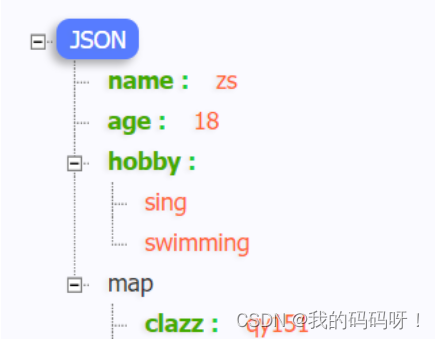
读取application.yml配置文件中的值并赋值给Student类中的属性
server:
port: 8082
student:
name: zs
age: 18
hobby:
- sing
- dance
- rap
- basketball
map:
clazz: qy151 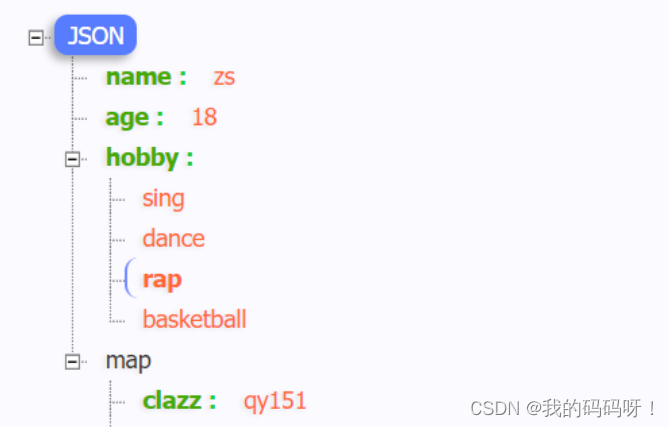
@Value 只能放在我们的类属性上。而且它只能读取基本类型和字符串类型。
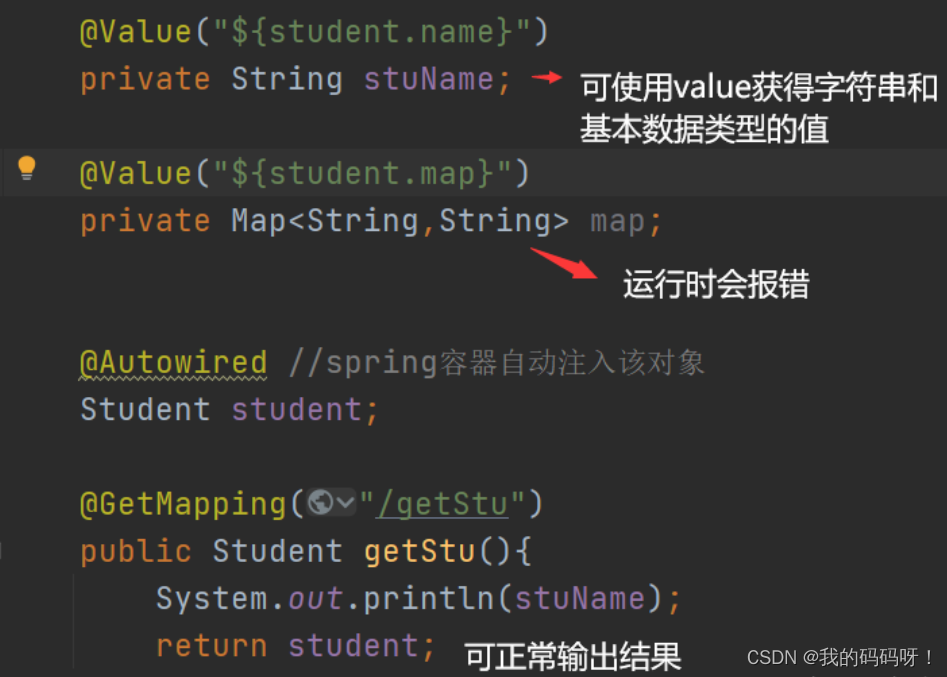
1.4 profiles配置详解
为什么要使用profiles?
在开发中,一般有两种环境
1,生产环境 [项目上线,客户在使用中,就是生产环境]
2,开发环境[就是开发环境,不解释]
有时候开发环境和生产环境的配置方法是不一样的,那么如何快速的切换呢,这里就要使用profiles文件
使用方法
1,创建applicatin-developer.properties
server.port=8081
2,创建applicatin-product.properties
server.port=8082
3,修改application.properties
#server.port=8080
spring.profiles.active=developer
4. 测试
5,总结
在application.properteis里面激活哪个文件就会使用哪个端口
2. WEB三大组件的注册
web的三个组件: Servlet和Filter以及Linstener监听器。
2.1 注册Servlet
创建Servlet
public class MyServlet extends HttpServlet {
@Override
protected void service(HttpServletRequest req, HttpServletResponse resp) throws ServletException, IOException {
System.out.println("这时自己定义的servlet~~~~~~~~~~~~~~~~~~~~~~~~~~~~~~");
}
}配置类
@Configuration //该类为配置类 xml文件
public class MyConfig {
@Bean //理解为配置文件中<bean >
public ServletRegistrationBean<Servlet> registrationBean(){
//创建一个Servlet注册器.
ServletRegistrationBean<Servlet> registrationBean=new ServletRegistrationBean<>();
registrationBean.setName("my");
registrationBean.setServlet(new MyServlet());
registrationBean.addUrlMappings("/my");
return registrationBean;
}
}2.2 注册Filter
创建Filter
public class MyFilter implements Filter {
@Override
public void doFilter(ServletRequest servletRequest, ServletResponse servletResponse, FilterChain filterChain) throws IOException, ServletException {
System.out.println("经过了过滤器");
filterChain.doFilter(servletRequest,servletResponse);
}
}配置类
@Configuration //该类为配置类 xml文件
public class MyConfig {
@Bean
public FilterRegistrationBean<Filter> filterRegistrationBean(){
FilterRegistrationBean<Filter> filterRegistrationBean=new FilterRegistrationBean<>();
filterRegistrationBean.setName("myfilter");
filterRegistrationBean.setFilter(new MyFilter());
filterRegistrationBean.addUrlPatterns("/*");
return filterRegistrationBean;
}
}
3. springboot自动装配
自动装配在SpringBoot是基于EnableAutoConfiguration来实现的。springboot的自动装配启动类上的注解@SpringBootApplication有关
spring boot自动装配原理
注解@EnableAutoConfiguraction,@Configuration,@ConditionalOnClass 就是⾃动配置 的核⼼,⾸先它得是⼀个配置⽂件,其次根 据类路径下是否有这个类取⾃动配置。
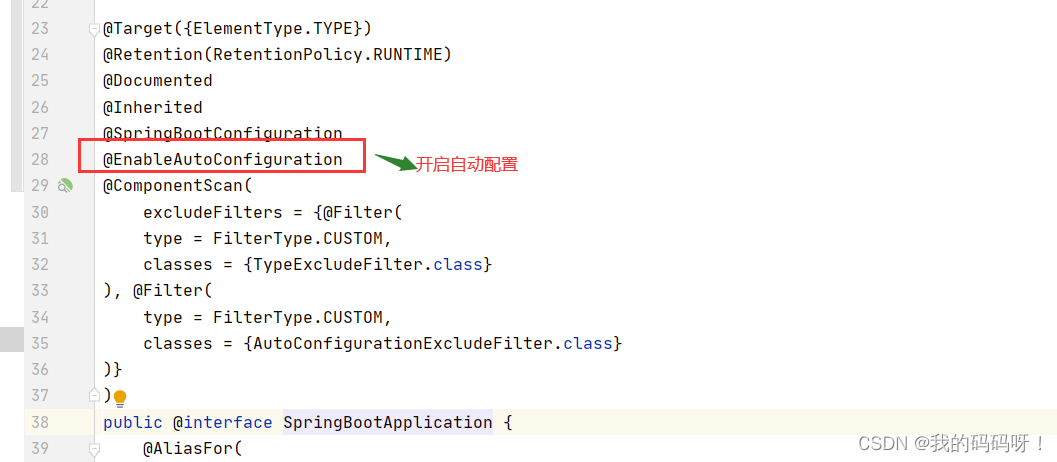

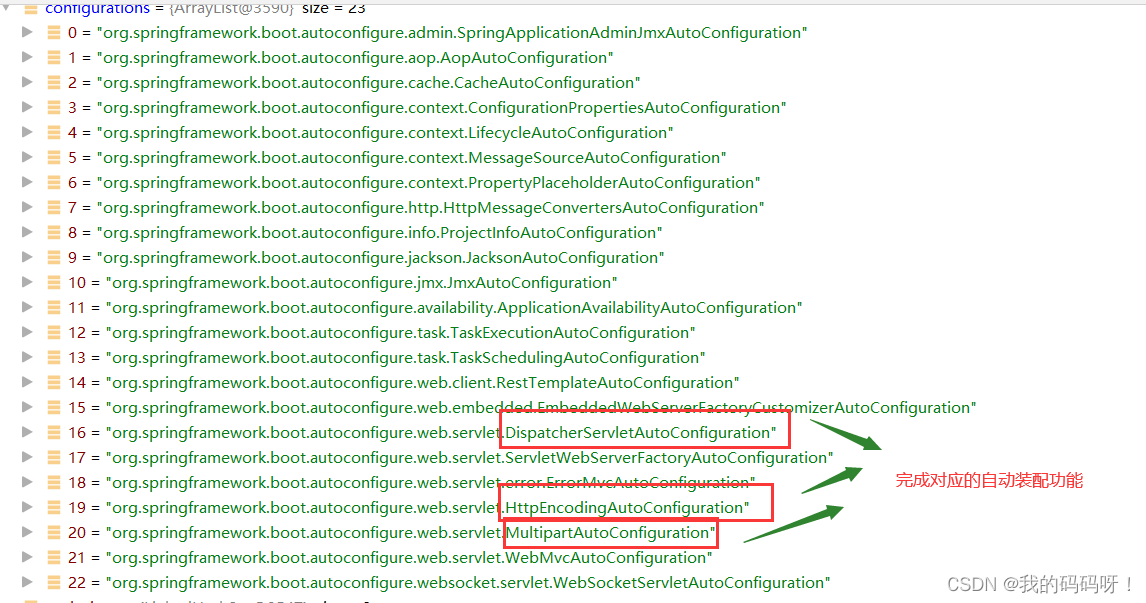
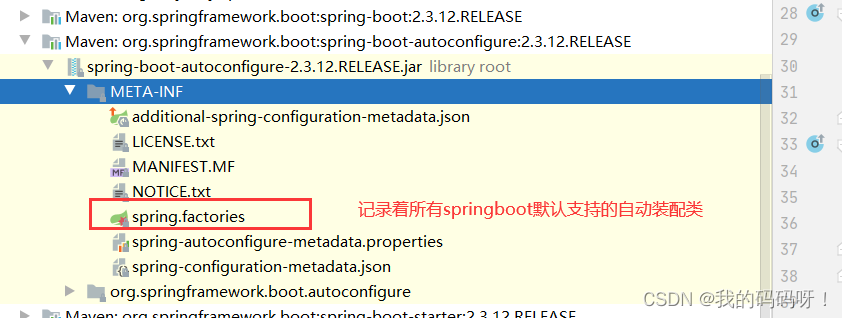

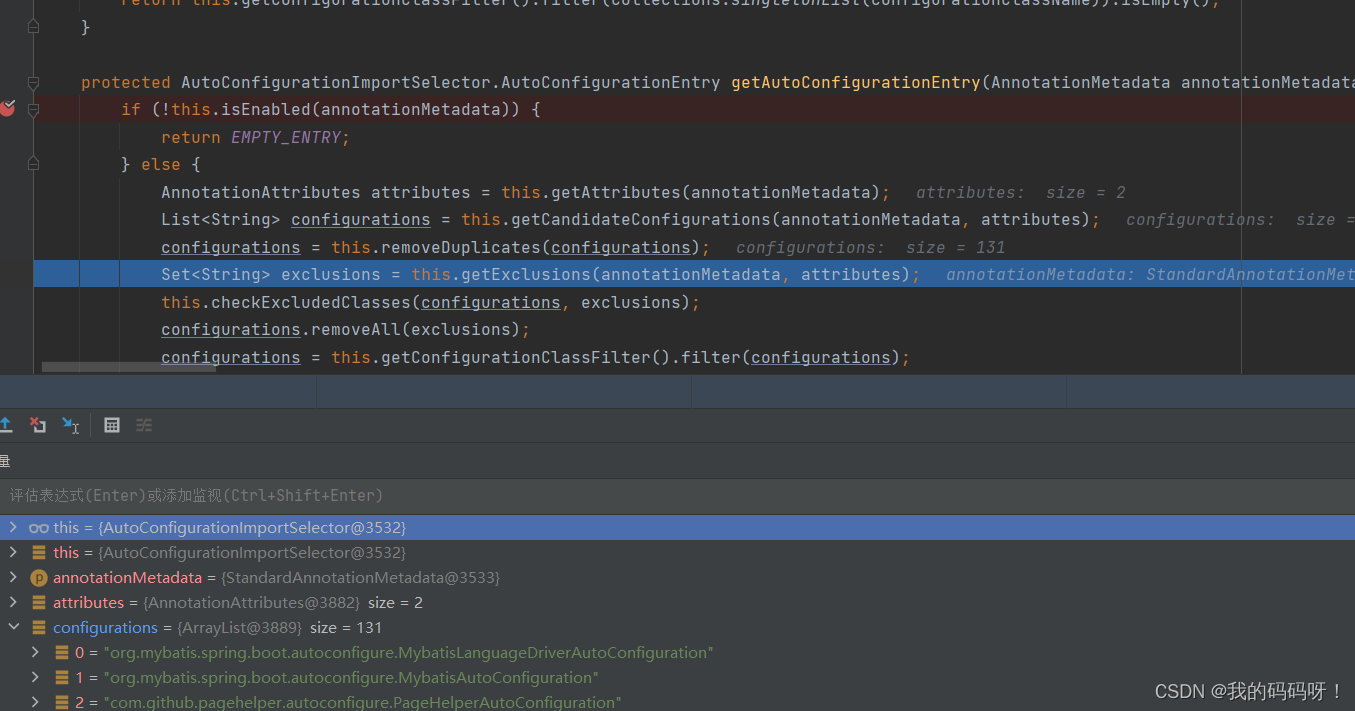
4. springboot整合数据源
4.1 整合数据源
数据源即数据库中的数据,也就是springboot连接数据库 默认数据源使用的连接池Hikari。如果不想使用默认的连接池,我们可以引入第三方的连接池。如druid
(1)导入依赖
<!--加入数据源的启动依赖: springboot启动时会加载对应的自动装配类。-->
<dependency>
<groupId>repMaven.org.springframework.boot</groupId>
<artifactId>spring-boot-starter-jdbc</artifactId>
<version>2.6.7</version>
</dependency>
<dependency>
<groupId>mysql</groupId>
<artifactId>mysql-connector-java</artifactId>
</dependency>(2)配置数据源信息—application.properties
spring.datasource.driver-class-name=com.mysql.cj.jdbc.Driver
spring.datasource.url=jdbc:mysql://localhost:3306/mydb?serverTimezone=Asia/Shanghai
spring.datasource.username=root
spring.datasource.password=123456
(3)单元测试
@SpringBootTest
class ApplicationTests {
@Autowired
private DataSource dataSource;
@Test
void contextLoads() throws SQLException {
System.out.println(dataSource.getConnection());
}
}4.2 集成druid数据源
(1)引入依赖
<dependency>
<groupId>com.alibaba</groupId>
<artifactId>druid-spring-boot-starter</artifactId>
<version>1.2.8</version>
</dependency>(2)配置文件
spring.datasource.druid.url=jdbc:mysql://localhost:3306/mydb?serverTimezone=Asia/Shanghai
spring.datasource.druid.driver-class-name=com.mysql.cj.jdbc.Driver
spring.datasource.druid.username=root
spring.datasource.druid.password=123456
#初始化的个数
spring.datasource.druid.initial-size=5
# 最大活跃数
spring.datasource.druid.max-active=10
# 最大等待时间
spring.datasource.druid.max-wait=3000
# 最小的闲置个数
spring.datasource.druid.min-idle=5(3)测试
@Test
void test01() {
System.out.println(dataSource);
}5. springboot整合mybatis
(1)引入依赖
<dependency>
<groupId>org.mybatis.spring.boot</groupId>
<artifactId>mybatis-spring-boot-starter</artifactId>
<version>2.2.2</version>
</dependency>(2)修改配置文件
#指定映射文件的路径
mybatis.mapper-locations=classpath:mapper/*.xml(3)创建数据
(1)创建实体类
@Data
public class Dept {
private Integer id;
private String name;
private String address;
}(2)在dao层中写一个简单得查询接口
@Mapper
@Component
public interface DeptDao {
Dept findById (Integer id);
List<Dept> findAll();
}
(3)在mapper层中写查询语句
<?xml version="1.0" encoding="UTF-8"?>
<!DOCTYPE mapper PUBLIC "-//mybatis.org//DTD Mapper 3.0//EN" "http://mybatis.org/dtd/mybatis-3-mapper.dtd">
<mapper namespace="com.example.dao.DeptDao">
<select id="findById" resultType="com.example.entity.Dept">
select * from tb_dept where id=#{id}
</select>
<select id="findAll" resultType="com.example.entity.Dept">
select * from tb_dept
</select>
</mapper>(4)在主启动类上加入注解
@SpringBootApplication
@MapperScan(basePackages = "com.example.dao") //为指定包下的接口生成代理实现类
public class DemoApplication {
public static void main(String[] args) {
SpringApplication.run(DemoApplication.class,args);
}
}
(5) 测试
@Autowired
private DeptDao deptDao;
@Test
void test02(){
System.out.println(deptDao.findById(4));
}6. springboot整合PageHelper分页插件
(1)引入依赖
<dependency>
<groupId>com.github.pagehelper</groupId>
<artifactId>pagehelper-spring-boot-starter</artifactId>
<version>1.4.2</version>
</dependency>(2) 测试
@Autowired
private DeptDao deptDao;
@Test
void test03() {
PageHelper.startPage(1,10);
List<Dept> list = deptDao.findAll();
PageInfo<Dept> pageInfo = new PageInfo<>(list);
System.out.println("当前页数"+pageInfo.getPageNum());
System.out.println("当前总页码"+pageInfo.getPages());
System.out.println("总条数"+pageInfo.getTotal());
System.out.println("当前页码的纪录"+pageInfo.getList());
}7. springboot整合swagger
swagger它是一个接口文档----用来前后端分离的一款文档。
swagger通过注解表明该接口会生成文档,包括接口名、请求方法、参数、返回信息的等等。
@Api:修饰整个类,描述Controller的作用
@ApiOperation:描述一个类的一个方法,或者说一个接口
@ApiParam:单个参数描述
@ApiModel:用对象来接收参数
@ApiModelProperty:用对象接收参数时,描述对象的一个字段
@ApiImplicitParam:一个请求参数
@ApiImplicitParams:多个请求参数
(1)引入依赖
<dependency>
<groupId>com.spring4all</groupId>
<artifactId>swagger-spring-boot-starter</artifactId>
<version>1.9.1.RELEASE</version>
</dependency>
<dependency>
<groupId>com.github.xiaoymin</groupId>
<artifactId>swagger-bootstrap-ui</artifactId>
<version>1.7.8</version>
</dependency>
(2)创建swagger配置类
@Configuration
public class SwaggerConfig {
@Bean //swagger中所有的功能都封装再Docket类中。
public Docket docket() {
Docket docket = new Docket(DocumentationType.SWAGGER_2)
.apiInfo(apiInfo())//设置api文档信息
.select()
.apis(RequestHandlerSelectors.basePackage("com.example.demo.controller")) //指定为哪些包下的类生成接口文档。
.build()
;
return docket;
}
//定义自己接口文档信息
private ApiInfo apiInfo() {
Contact DEFAULT_CONTACT = new Contact("名称", "www.baidu.com", "www.baidu.com");
ApiInfo apiInfo = new ApiInfo("CRUD", "对tb_dept表进行增删改查", "3.0T", "www.baidu.com",
DEFAULT_CONTACT, "AAA", "www.baidu.com", new ArrayList<VendorExtension>());
return apiInfo;
}
}
(3)在主启动类中开启swagger注解
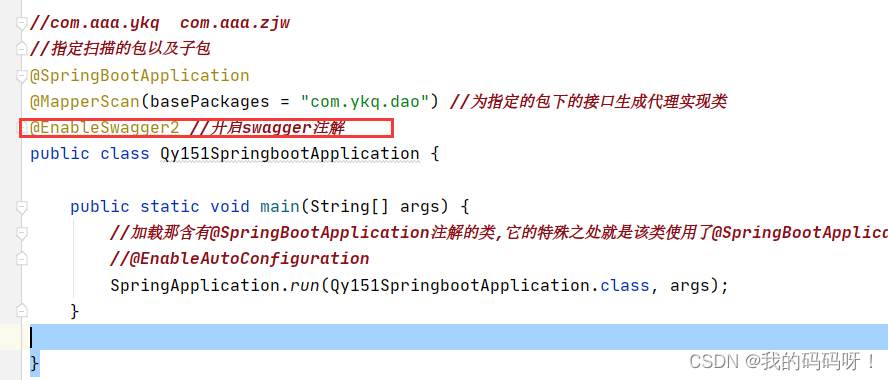
(4)访问
























 1万+
1万+











 被折叠的 条评论
为什么被折叠?
被折叠的 条评论
为什么被折叠?








